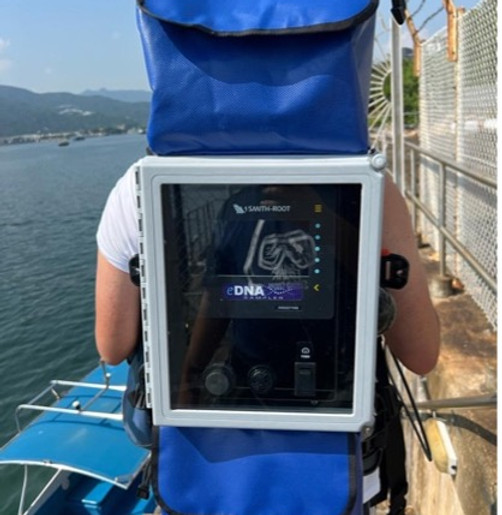Feasibility study of detecting local seahorse and pipefish species in the coastal area of Hong Kong by environmental DNA (eDNA)
Funded by: Marine Conservation Enhancement Fund
Global Syngnathidae populations are being threatened by habitat destruction, pollution from human activities, and bycatch caused by non-selective fishing methods. To conserve and protect these threatened species and their habitats, it is crucial to provide precise and scientific survey results for the government to develop effective conservation management plans.
Traditionally, Syngnathidae species are surveyed through underwater visual observations conducted by divers. However, this method is time-consuming, requires subsequent morphological identification of specimens based on taxonomic expertise, and is prone to oversight due to the species’ small size, camouflage, and preference for low-visibility environments.
With the use of environmental DNA (eDNA) methods, local Syngnathidae populations across all parts of Hong Kong can be systematically and comprehensively investigated in a manner that is fast, safe, and minimally invasive to their habitats. This study represents the first substantial investigation of local Syngnathidae populations using eDNA methods in Hong Kong, and the findings will also benefit nearby regions, including China and Southeast Asia.
Research objectives
-
To conduct a comprehensive and systemic survey of Syngnathidae in Hong Kong by eDNA methods and underwater visual survey.
-
To develop an eDNA method specific for the yellow seahorse.

© Coral Academy
About Yellow Seahorse Hippocampus kuda
-
Yellow seahorses are commonly found in waters up to 7 meters deep in the eastern part of Hong Kong.
-
Once a common species in Hong Kong several decades ago, it has become increasingly rare due to overfishing for traditional medicine, habitat destruction, and marine pollution.
-
Since 2004, it has been listed in Appendix II of the Convention on International Trade in Endangered Species of Wild Fauna and Flora (CITES) (www.cites.org).
-
It is classified as “Vulnerable” in the IUCN Red List of Threatened Species (www.iucnredlist.org).

© Coral Academy
What is environmental DNA (eDNA)?
-
When organisms inhabit or pass through a place, their DNA will be scattered in the surrounding environment through shed skin cells, excrement, secretions, etc. Environmental DNA (eDNA) refers to DNA collected directly from environmental samples such as soil, seawater, sediment, or air.

© Coral Academy
Why do we use eDNA to investigate pipefish and seahorses?
-
Previous pipefish and seahorse surveys mainly focused on the eastern waters of Hong Kong, and data in the southern and western areas remains limited.
-
Due to the low visibility of Hong Kong’s seawater, divers may easily overlook the small cryptic seahorses and pipefish.
-
Closely related seahorse and pipefish species share similar appearances, requiring a certain level of expertise to accurately identify the species.
-
Underwater visual surveys can be invasive, as divers and their equipment may disturb marine organisms and cause habitat destruction.
-
eDNA has been considered a non-destructive and cost-effective tool that can provide sensitive, accurate, unbiased, and high-resolution ecological data.

© Coral Academy
Research Methods
-
We collected water samples from 12 study sites distributed in the eastern, southern, and western waters of Hong Kong. Then we identified pipefish and seahorse species in the samples by eDNA methods.
-
We conducted aquarium experiments in Simon F.S. Li Marine Science Laboratory (MSL) at the Chinese University of Hong Kong to evaluate the effectiveness of eDNA methods.

© Coral Academy
Research Findings
-
eDNA captured a higher number of seahorse and pipefish species than the underwater visual census approach in the survey.
-
eDNA results unveiled the cryptic distribution of seahorse and pipefish species in Hong Kong’s estuaries and central coastal areas, which may not be observable through underwater visual surveys.
-
eDNA data revealed seasonal variations in Syngnathidae species composition.

© Coral Academy
Visiting these seahorses in Ocean Park Hong Kong!
-
The Coral Academy research team obtained an import permit under the Convention on International Trade in Endangered Species of Wild Fauna and Flora (CITES) and legally purchased the artificially bred yellow seahorses from Australia, and raised them in the laboratory for the research.
-
Since these yellow seahorses used are not from Hong Kong, they cannot be released directly into the wild after the experiment to avoid polluting the local ecology.
-
The Coral Academy eventually donated all the yellow seahorses to Ocean Park Hong Kong for display and educational purposes. Under the careful care of Ocean Park caregivers, they have been settled in Ocean Park and are ready to meet everyone at the Grand Aquarium! Welcome everyone to visit them in the Park and learn more about the information on yellow seahorses and the eDNA technology.

© Coral Academy
